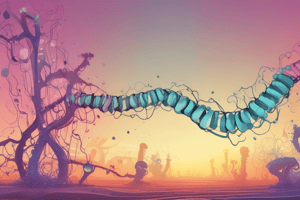Podcast
Questions and Answers
What is the primary purpose of PCR in molecular biology?
What is the primary purpose of PCR in molecular biology?
- To extract and purify DNA from a sample, removing any contaminating biomolecules
- To degrade all DNA within a sample for analysis
- To identify the different types of proteins present within a cell
- To create multiple copies of a specific DNA sequence within a DNA sample (correct)
Which of the following characteristics is MOST important when designing primers for PCR?
Which of the following characteristics is MOST important when designing primers for PCR?
- Having a length of over 50 base pairs to ensure high specificity
- Consisting of a base composition with less than 30% GC content to minimize secondary structures
- Being complementary to both ends of the DNA fragment targeted for amplification (correct)
- Having a high degree of self-complementarity to form stable hairpin structures
Why is it important to avoid self-complementary sequences when designing PCR primers?
Why is it important to avoid self-complementary sequences when designing PCR primers?
- Self-complementary sequences can lead to the formation of primer dimers or hairpin loops, reducing amplification efficiency. (correct)
- Self-complementary sequences increase the specificity of the primer for the target DNA.
- Self-complementary sequences are necessary for efficient DNA polymerase binding and extension.
- Self-complementary sequences ensure that the primers bind more tightly to the DNA template.
A researcher is designing PCR primers for a gene with a known sequence. Which of the following primer pairs is MOST likely to result in successful PCR amplification?
A researcher is designing PCR primers for a gene with a known sequence. Which of the following primer pairs is MOST likely to result in successful PCR amplification?
During DNA extraction and purification, which step is specifically aimed at removing proteins, lipids, and polysaccharides from the sample?
During DNA extraction and purification, which step is specifically aimed at removing proteins, lipids, and polysaccharides from the sample?
If a PCR experiment results in multiple bands of different sizes instead of a single band of the expected size, what is the MOST likely cause?
If a PCR experiment results in multiple bands of different sizes instead of a single band of the expected size, what is the MOST likely cause?
A molecular biologist is using PCR to amplify a specific gene from a DNA sample. After several attempts, the PCR consistently fails to produce any product. Assuming the reagents are fresh and the PCR machine is functioning correctly, which of the following is the MOST probable cause of the failure?
A molecular biologist is using PCR to amplify a specific gene from a DNA sample. After several attempts, the PCR consistently fails to produce any product. Assuming the reagents are fresh and the PCR machine is functioning correctly, which of the following is the MOST probable cause of the failure?
A researcher is investigating a new bacterial species and wants to determine if a specific virulence gene is present. They perform PCR using primers designed to amplify the virulence gene, but no band appears on the gel after electrophoresis. What should the researcher do to CONFIRM that the negative result is not due to a problem with the PCR itself?
A researcher is investigating a new bacterial species and wants to determine if a specific virulence gene is present. They perform PCR using primers designed to amplify the virulence gene, but no band appears on the gel after electrophoresis. What should the researcher do to CONFIRM that the negative result is not due to a problem with the PCR itself?
Flashcards
PCR Aim
PCR Aim
Identifying and detecting a specific DNA sequence within a complex genome.
PCR Specificity Issue
PCR Specificity Issue
The challenge of targeting one specific sequence among many.
PCR Amplification Issue
PCR Amplification Issue
The need to create many copies of a small amount of DNA for analysis.
Polymerase Chain Reaction (PCR)
Polymerase Chain Reaction (PCR)
Signup and view all the flashcards
Primers (Oligonucleotides)
Primers (Oligonucleotides)
Signup and view all the flashcards
Primer Length
Primer Length
Signup and view all the flashcards
Primer GC Content
Primer GC Content
Signup and view all the flashcards
DNA Extraction and Purification
DNA Extraction and Purification
Signup and view all the flashcards
Study Notes
- The goal of PCR is to identify and detect a specific sequence in a genome.
- PCR faces challenges related to specificity and amplification.
- There are many sequences in a genome that are not of interest in detection.
- The amount of DNA in samples of interest is often very small.
Polymerase Chain Reaction
- PCR is a cell-free method.
- It uses a heat-stable DNA polymerase.
- It synthesizes copies (amplification) of a predetermined DNA segment of interest.
- It starts within a complex starting DNA material.
Primers (Oligonucleotide)
- Primers are short nucleic acid sequences.
- They serve as a starting point for DNA synthesis.
- Primers are complementary to both ends of the targeted DNA fragment.
- Length should be 18-25 base pairs.
- Base composition should have a GC content of 40-60%.
- The 3' end of one primer should not be complementary to any region on the second primer.
- Self-complementary sequences, inverted repeats and self-complementary sequences should be avoided.
Sample Type
- Sample type can be any nucleic acid containing samples
DNA Extraction and Purification
- DNA isolation protocols include disruption of the cell wall, cell membrane, and nuclear membrane.
- This releases the DNA into solution
- This is followed by precipitation of DNA.
- It removes contaminating biomolecules (proteins, polysaccharides, lipids, phenols, and other secondary metabolites).
Studying That Suits You
Use AI to generate personalized quizzes and flashcards to suit your learning preferences.




